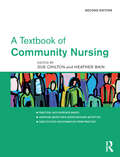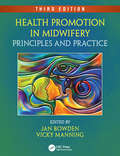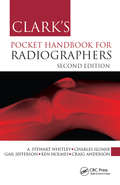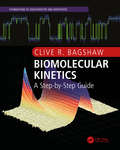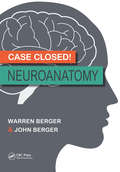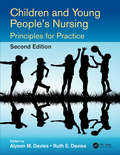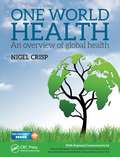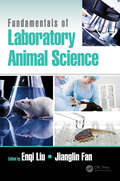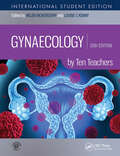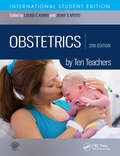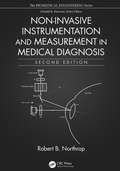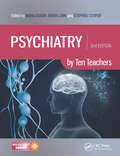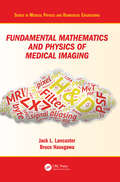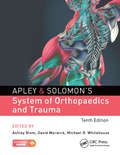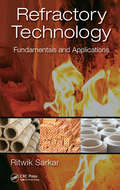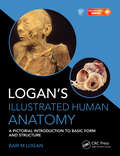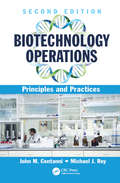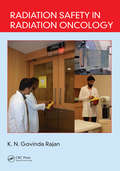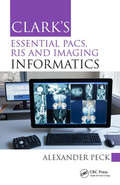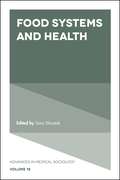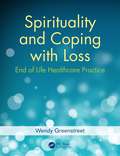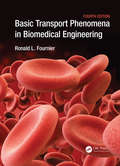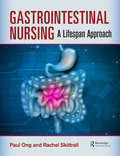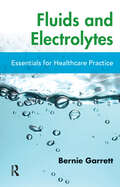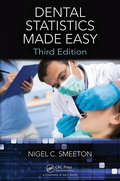- Table View
- List View
A Textbook of Community Nursing
by Sue Chilton Heather BainA Textbook of Community Nursing is a comprehensive and evidence-based introduction covering the full range of professional topics, including professional approaches to care, public health, eHealth, therapeutic relationships and the role of community nursing in mental health. The new edition has been updated throughout, including new guidelines and policies. It also provides a stronger focus on evidence-based practice. This user-friendly and accessible textbook includes: Current theory, policy, and guidelines for practice. All chapters are underpinned by a strong evidence base; Learning objectives for each chapter, plus exercises and activities to test current understanding, promote reflective practice, and encourage further reading; Case studies and examples from practice which draw on all branches of community nursing to illustrate practical application of theory. This is an essential text for all pre-registration nursing students, students on specialist community nursing courses, and qualified nurses entering community practice for the first time.
Health Promotion in Midwifery: Principles and Practice, Third Edition
by Jan Bowden Sam BassettHealth Promotion in Midwifery explores the principles of health promotion within the practical context of midwifery. It clearly outlines and discusses the midwife’s role in health promotion, linking theory and practice. The third edition of this evidence-based text covers essential topics such as breastfeeding, smoking, mental health, behaviour change and sexual health promotion and includes new chapters on healthy eating in pregnancy, pelvic floor health during the childbearing years and violence against women. All the chapters are updated and some are completely rewritten to reflect recent changes and developments in midwifery practice. Text boxes make the text accessible and user-friendly, and case studies and summaries put the material in practical context. Additional readings encourage readers to further research and reflection on their own practice. This textbook is essential reading for midwives and health visitors in education and practice.
Clark's Pocket Handbook for Radiographers (Clark's Companion Essential Guides)
by A Stewart Whitley Charles Sloane Gail Jefferson Ken Holmes Craig AndersonDrawn from the bestselling Clark's Positioning in Radiography, this pocket handbook provides clear and practical advice to help radiographers in their day-to-day work. Designed for rapid reference, it covers how to position the patient and the central ray, describes the essential image characteristics and illustrates each radiographic projection with a positioning photograph and a radiograph.
Biomolecular Kinetics: A Step-by-Step Guide (Foundations of Biochemistry and Biophysics)
by Clive R. Bagshaw"a gem of a textbook which manages to produce a genuinely fresh, concise yet comprehensive guide"–Mark Leake, University of York "destined to become a standard reference…. Not just a ‘how to’ handbook but also an accessible primer in the essentials of kinetic theory and practice."–Michael Geeves, University of Kent "covers the entire spectrum of approaches, from the traditional steady state methods to a thorough account of transient kinetics and rapid reaction techniques, and then on to the new single molecule techniques" –Stephen Halford, University of Bristol This illustrated treatment explains the methods used for measuring how much a reaction gets speeded up, as well as the framework for solving problems such as ligand binding and macromolecular folding, using the step-by-step approach of numerical integration. It is a thoroughly modern text, reflecting the recent ability to observe reactions at the single-molecule level, as well as advances in microfluidics which have given rise to femtoscale studies. Kinetics is more important now than ever, and this book is a vibrant and approachable entry for anyone who wants to understand mechanism using transient or single molecule kinetics without getting bogged down in advanced mathematics. Clive R. Bagshaw is Emeritus Professor at the University of Leicester, U.K., and Research Associate at the University of California at Santa Cruz, U.S.A.
Case Closed! Neuroanatomy
by Warren Berger John BergerThis carefully-designed textbook offers a brand-new approach to learning neuroanatomy for medical students and newly-qualified doctors, particularly those considering a career in neurology and neurosurgery. Promoting active learning and taking inspiration from other popular case-based formats, readers are encouraged to overcome their inherent ‘neurophobia’. The accessible text and practical examples, unencumbered by esoteric minutiae, support students and trainees in developing the necessary skills that will be essential in later clinical practice. Developed specifically in response to student feedback, the authors have succeeded in creating a novel, brief, and high-yield primer that offers a unique approach to mastering this challenging discipline. Case Closed! Neuroanatomy not only teaches students how to localize, but also guides them to solve successfully the problems that will reappear in their exams and in the clinic.
Children and Young People's Nursing: Principles for Practice, Second Edition
by Alyson M. Davies Ruth E. DaviesUnderpinned by a rights-based approach, this essential text critically analyses the theory and practice of children and young people’s nursing from several perspectives - public health, acute and community based care, education and research. Chapters address the clinical, legal, ethical, political and professional issues and controversies which impact on the care delivered to children, young people and their families both nationally and internationally. This new edition continues to promote reflection and critical thinking about the practice of children’s nursing and professional development.
One World Health: An Overview of Global Health
by Lord Nigel CrispThis brand new textbook presents a new approach to the teaching and understanding of global health. It describes the shared opportunities but also the problems that we all face, wherever we live, and the particular needs of the poorest people in every society. Covering subjects from epidemics and climate change, the need to staff and resource health services appropriately, the rich potential of science and technology, and the impacts of social and political change in the world around us, all is presented at a level appropriate for the student looking to gain an understanding of this broad and developing area.
Fundamentals of Laboratory Animal Science
by Enqi Liu Jianglin FanLaboratory animals are becoming increasingly important for biomedical research. It is said that approximately 70% of biomedical research is associated with the use of experimental animals. Laboratory animal research not only expands our knowledge of science, but also greatly improves human and animal health. The field of laboratory animal science is ever-growing and changing as new experimental techniques are developed and new animal models are created. It is essential to know not only the biological features of each laboratory animal but also how to use and care for them responsibly in order to perform high-quality experiments. Courses in beginning Laboratory Animal Science are starting to be offered in many universities throughout the world. However, a practical introductory textbook that contains state-of-the-art techniques is still lacking. Fundamentals of Laboratory Animal Science provides comprehensive information on the principles and practices of using laboratory animals for biomedical research. Each individual chapter focuses on a key sub-discipline of laboratory animal science: animal welfare and best humane care practices in the laboratory; the quality control of laboratory animals; the anatomy, physiology, and husbandry of commonly used species; the principles of creating and using animal models for studying human diseases; practical techniques used for laboratory animal experiments; experimental design; and animal experimentation management. Knowledge of this broad spectrum of concepts and skills will ensure research goes smoothly while greatly reducing animal pain and distress. Well-illustrated and thoroughly referenced, this book will serve not only as a standard textbook but also as a handy guide for veterinarians, researchers, animal care staff, administrators, and other professionals who are involved in laboratory animal science.
Gynaecology by Ten Teachers
by Louise C. Kenny Helen BickerstaffFirst published in 1919 as 'Diseases of Women', Gynaecology by Ten Teachers is well established as a concise, yet comprehensive, guide. The twentieth edition has been thoroughly updated by a new team of 'teachers', integrating clinical material with the latest scientific developments that underpin patient care. Each chapter is highly structured, with learning objectives, definitions, aetiology, clinical features, investigations, treatments, case histories and key point summaries and additional reading where appropriate. New themes for this edition include 'professionalism' and 'global health' and information specific to both areas is threaded throughout the text.
Obstetrics by Ten Teachers
by Louise C. Kenny Jenny E. MyersFirst published in 1917 as 'Midwifery', Obstetrics by Ten Teachers is well established as a concise, yet comprehensive, guide within its field. The twentieth edition has been thoroughly updated by a new team of 'teachers', integrating clinical material with the latest scientific developments that underpin patient care. Each chapter is highly structured, with learning objectives, definitions, aetiology, clinical features, investigations, treatments, case histories and key point summaries and additional reading where appropriate. New themes for this edition include 'professionalism' and 'global health' and information specific to both areas is threaded throughout the text. Along with its companion Gynaecology by Ten Teachers the book will continue to provide an accessible 'one stop shop' in obstetrics and gynaecology for a new generation of doctors.
Non-Invasive Instrumentation and Measurement in Medical Diagnosis (Biomedical Engineering)
by Robert B. NorthropNon-Invasive Instrumentation and Measurement in Medical Diagnosis, Second Edition discusses NIMD as a rapidly growing, interdisciplinary field. The contents within this second edition text is derived from Professor Robert B. Northrop’s experience teaching for over 35 years in the Biomedical Engineering Department at the University of Connecticut. The text focusses on the instruments and procedures which are used for non-invasive medical diagnosis and therapy, highlighting why NIMD is the preferred procedure, whenever possible, to avoid the risks and expenses associated with surgically opening the body surface. This second edition also covers a wide spectrum of NIMD topics including: x-ray bone densitometry by the DEXA method; tissue fluorescence spectroscopy; optical interferometric measurement of nanometer tissue displacements; laser Doppler velocimetry; pulse oximetry; and applications of Raman spectroscopy in detecting cancer, to name a few. This book is intended for use in an introductory classroom course on Non-Invasive Medical Instrumentation and Measurements taken by juniors, seniors, and graduate students in Biomedical Engineering. It will also serve as a reference book for medical students and other health professionals intrigued by the topic. Practicing physicians, nurses, physicists, and biophysicists interested in learning state of the art techniques in this critical field will also find this text valuable. Non-Invasive Instrumentation and Measurement in Medical Diagnosis, Second Edition concludes with an expansive index, bibliography, as well as a comprehensive glossary for future reference and reading.
Psychiatry by Ten Teachers
by Nisha Dogra Brian Lunn Stephen CooperPsychiatry by Ten Teachers follows the highly-praised and successful ‘Ten Teachers’ tradition of providing the key information in a chosen specialty as required by the medical undergraduate, junior doctor and trainee GP, written by ten respected experts in the field. With medical students closely involved in the text’s development from the outset the text focuses on what the medical student and junior really need to know, with a clear rationale for the inclusion of every topic discussed at a level appropriate for the inexperienced, and will be of value to their future career whatever field they ultimately decide to specialize in. Completely up to date, this revised second edition encourages students and recently qualified doctors to get the most out of their psychiatry and community attachments, without overwhelming them with unnecessary detail. In line with the core curriculum recommended by the Royal College of Psychiatry, useful tips and advice ensure this is much more than a standard introduction to the subject, encouraging additional reading, supporting critical thinking and bringing exam success.
Fundamental Mathematics and Physics of Medical Imaging (Series in Medical Physics and Biomedical Engineering)
by Jack Lancaster Bruce HasegawaAuthored by a leading educator, this book teaches the fundamental mathematics and physics concepts associated with medical imaging systems. Going beyond mere description of imaging modalities, this book delves into the mechanisms of image formation and image quality common to all imaging systems: contrast mechanisms, noise, and spatial and temporal resolution, making it an important reference for medical physicists and biomedical engineering students. This is an extensively revised new edition of The Physics of Medical X-Ray Imaging by Bruce Hasegawa (Medical Physics Publishing, 1991), and includes a wide range of modalities such as X-ray CT, MRI and SPECT.
Apley & Solomon�s System of Orthopaedics and Trauma
by Ashley Blom David Warwick Michael WhitehouseNow in its Tenth Edition and in continuous publication since 1959, Apley & Solomon's System of Orthopaedics and Trauma is one of the world's leading textbooks of orthopaedic surgery. Relied upon by generations of orthopaedic trainees the book remains true to the teaching principles of the late Alan Apley and his successor Professor Louis Solomon. This new edition is fully revised and updated under the leadership of new editors. It retains the familiar 'Apley' philosophy and structure, and is divided into three major sections: General Orthopaedics, Regional Orthopaedics and Trauma, thus enabling readers to gain the knowledge they need for their lifetime learning.
Refractory Technology: Fundamentals and Applications
by Ritwik SarkarThis book provides a basic understanding of refractories. This includes the fundamentals of refractory technology supported by phase diagrams as well as detailing the prominent applications of these essential industrial materials. This book covers all the facets of refractory technology, starting from classification, properties, standard specifications, details of the conventional shaped refractories, including relevant phase diagrams & application areas and also the details of unshaped refractories including various classifications, bonding, additives and their applications.
Logan's Illustrated Human Anatomy
by Bari M. LoganThis concise illustrated volume presents a pictorial guide to human anatomy through the meticulous dissections of Bari Logan, assembled during his long career as a distinguished prosector, and representing an unrivalled collection of superb photographic images. Illustrations are fully labelled, and accompanied by brief clinical notes to provide additional guidance for the student. Material covering anatomical preparation and cadaver preservation, orientation and planes of section, the bones, muscles and cranial nerves and an extensive glossary provides supplemental detail. The book will be a convenient photographic companion to all core textbooks of anatomy and ideal during exam preparation.
Biotechnology Operations: Principles and Practices, Second Edition
by John M. Centanni Michael J. RoyThis book describes seven areas in the field of biotechnology operations as practiced by biopharmaceutical firms and nonprofit institutions. Revisions focus upon changes that have occurred in several areas over the past six years, with emphasis on regulatory, biomanufacturing, clinical and technical information, along with processes and guidlines that have added to the discipline. Examples are increased for new technical fields such as cell and tissue engineering. Further, illustrations or figures are added to each chapter to emphasize particular points.
Radiation Safety in Radiation Oncology
by K. N. Govinda RajanThe proposed book aims to explain the basic principles, concepts and regulations behind radiation protection and their application in the field of radiation oncology practice. This book will be useful to all those students, teachers and practicing professionals involved in the field of radiation oncology.
Clark's Essential PACS, RIS and Imaging Informatics (Clark's Companion Essential Guides)
by Alexander PeckImaging informatics is a complex and historically rapidly changing field, knowledge of which is central to the practice of all imaging specialists. This convenient pocket guide provides the foundations of knowledge in informatics, allowing radiographers in training and in practice, assistant practitioners and other allied health professionals to understand, use and develop more efficient ways of imaging that will in turn deliver improved patient care.
Food Systems and Health (Advances in Medical Sociology #18)
by Sara Shostak Brea L. PerryIn recent years, the ways in which food is produced, distributed, and consumed have emerged as prominent health and social issues. With rising concern about rates of obesity, food systems have attracted the attention of state actors, leading to both innovative and controversial public health interventions, such as citywide soda bans, “veggie prescription” initiatives, and farm-to-school programs. At the same time, social movement activism has emerged focused on issues related to food and health, including movements for food justice, food safety, farm worker’s rights, and community control of land for agricultural production. Meanwhile, many individuals and families struggle to obtain food that is affordable, accessible, and meaningfully connected to their cultures. Volume 18 of Advances in Medical Sociology brings cutting-edge sociological research to bear on these multiple dimensions of food systems and their impacts on individual and population health. This volume will highlight how food systems matter for health policy, health politics, and the lived experiences and life chances of individuals and communities.
Spirituality and Coping with Loss: End of Life Healthcare Practice
by Wendy GreenstreetSpirituality and Coping with Loss: End of Life Healthcare Practice describes a research study that reflects nurses’ experience of the nature of loss encountered in end of life care settings as well as the ways in which spirituality is a resource in coping in these situations. Key findings indicate how nurses’ spiritual development impacts their proficiency in spiritual care. These findings will be of interest to nurses and nurse educators as well as other healthcare professionals.
Basic Transport Phenomena in Biomedical Engineering
by Ronald L. FournierThis will be a substantial revision of a good selling text for upper division/first graduate courses in biomedical transport phenomena, offered in many departments of biomedical and chemical engineering. Each chapter will be updated accordingly, with new problems and examples incorporated where appropriate. A particular emphasis will be on new information related to tissue engineering and organ regeneration. A key new feature will be the inclusion of complete solutions within the body of the text, rather than in a separate solutions manual. Also, Matlab will be incorporated for the first time with this Fourth Edition.
Gastrointestinal Nursing: A Lifespan Approach
by Paul Ong Rachel SkittrallDisorders of the gastrointestinal tract make up some of the most common illnesses experienced across the lifespan affecting individuals in infancy, childhood and adulthood. This essential guide to the gastrointestinal system will enable nurses and allied health professionals to apply principles of anatomy and physiology to clinical practice. Taking a practical and evidence-based approach, each chapter explores associated anatomy, function and abnormalities. Chapters use selected pathology and associated pathophysiology, from across the lifespan, to support understanding of how disorders can disrupt the development and function of the gastrointestinal tract. The accessible writing style and full colour illustrations make this an ideal introduction for students and professionals new to gastrointestinal care.
Fluids and Electrolytes: Essentials for Healthcare Practice
by Bernard M. GarrettFluids and Electrolytes: Essentials for Healthcare Practice is designed to give a solid understanding of fluid and electrolyte physiology and its implications for practice, including acid-base balance and intravenous (IV) therapy, in a concise and easily understandable format. Chapters incorporate physiological, developmental and practical aspects, highlighting some of the key issues that arise from childhood to old age. This accessible text is presented with clear graphical representations of key processes, numerous tables and contains interesting facts to explore some common myths about human fluid and electrolyte physiology. A valuable resource for healthcare students, this book also provides a strong comprehensive overview for practitioners, nurses, physiotherapists and paramedics.
Dental Statistics Made Easy
by Nigel C. SmeetonThis essential textbook presents the basics of dental statistics in an accessible way, combining explanation in non-technical language with key messages, practical examples, suggestions for further reading and exercises complete with detailed solutions. There is an emphasis on the principles and application of statistics without the use of algebra. The statistical material is strongly rooted in practical examples drawn from a wide range of journal articles representing both dental health care delivery and clinical dentistry. The perspective is international, with papers drawn from a variety of settings around the world. Many articles are recent and report contemporary developments in dental care. The intended audience includes dental students and practitioners, those engaged in dental research and other health care professionals. For students and tutors, it covers the undergraduate curriculum, and the exercises and solutions make it ideal for course use. For practitioners and researchers it provides the first principles of study design, accessing the dental literature, and the preparation and publication of original dental research.
